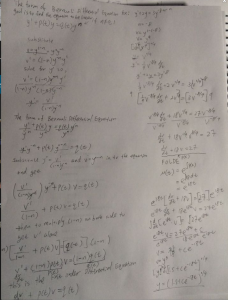 Bernoulli Differential Equations
Bernoulli Differential Equations
The form of Bernoulli Equations is y’+p(x) y=q(x)y^n, which n is just some real number. As we known that if n=1 or n=0 then after we plug it in to the n of the equation y’+p(x) y=q(x)y^n then we get y’+p(x) y=q(x)y^0 or y’+p(x) y=q(x)y^1. It shows you that it is just the first order linear differential equation that we already known how to solve it. However, if n ≠ 0, 1 then we need to use another method to solve it and it is called the Bernoulli equations. Here are the steps to solve the Bernoulli Differential Equations. In order to solve the Bernoulli Differential Equations as the first order linear differential equation first we need to set a) v=y^(1-n) and after we take the derivative of it we come up with b) v’= (1-n)y^(-n) y’.
We can get y’ alone by dividing by(1-n)y^(-n), and get y’=v’/((1-n) )*y^n. From the original Bernoulli Differential Equations y’+p(x) y=q(x)y^n. We can divided by y^n from the right side of the equation and get y^(-n) *[y]^’+y^(-n)*p(x)*y=q(x). Then we can substitute y’=v’/((1-n) )*y^n in to y’ in this equation y^(-n) 〖*y〗^’+y^(-n)*p(x) y=q(x) and gety^(-n) (v’/((1-n) ))*y^n+y^(1-n)*p(x) y=q(x), so we can cancel y^(-n) and y^n. We multiply (1-n) both side and get the First Order Differential equation v’ + (1-n)*p(x)*v= (1-n) =q(x)
Example:
y’+2y=3*y^(-8)
As we recognize that n≠1 or 0, so we need to use the Bernoulli Equations to transformed into a linear equation.
n=-8
put n=-8 in to the substitution of
v=y^(1-n)
v=y^(9)
we need to get y so, multiply the exponent 1/9 on each side and get
y=v^(1/9), then we take the derivative of it, and it becomes
y’=1/9*v^(-8/9)*(dv/dt)
after we get y’ and y then we can substitute in to the y’+2y=3*y^(-8) to solve for the linear equation
[1/9*v^(-8/9)*(dv/dt)]+[2v^(1/9)]=3(v^(-8/9))
then we multiply 1/9 on both side and divide by v^(-8/9), then we get
[dv/dt]+[18v]=27, and we recognize it is a First Order Linear Differential Equation dy/dx+p(x)y=f(x)
18 is p(x)
µ(t)=e^(∫p(x))
=e^(∫8dx)
=e^(18t)
we multiply e^(18t) of [dv/dt]+[18v]=27 and get
e^(18t)*[dv/dt]+e^(18t)*[18v]=e^(18t)*27
and take the integral on both side to get v alone so we can substitute y
∫d/dt[e^(18t)*v]=∫e^(18t)*27 and get
e^(18t)*v=27e^(18t)+c divide e^(18t) on both side
v=27/18+ce^(-18t)
we known that v=y^(9) from the beginning and plug it back to v
y^(9)=27/18+ce^(-18t), so we can multiply the exponent on both side by (1/9) and get the answer
y(t)=(1.5+ce^(-18t))^(1/9)
Here are the helpful videos that solve the Bernoulli equation step by step.
1.
Part 1
Part 2
2.



